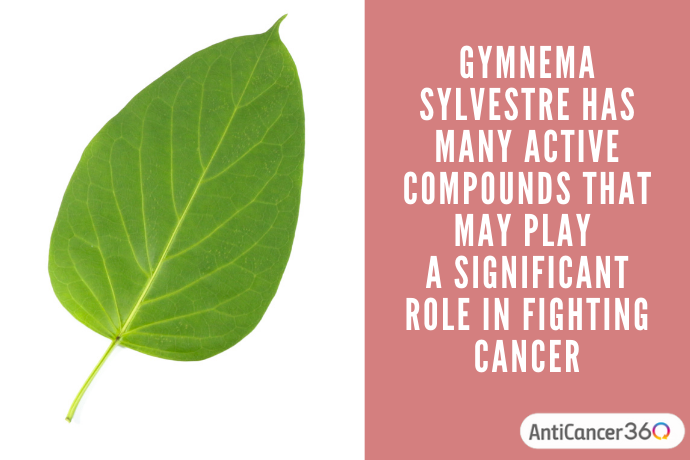Receiving a cancer diagnosis can be overwhelming and scary, often catching you off guard. However, due to advancements in medicine and science, you now have a wide array of effective treatment options. In addition to oncology treatment, you have access to many additional options that can augment your approach to therapy.
Maintaining a healthy lifestyle through a well-balanced diet, exercise, and incorporating natural supplements are fantastic ways you can help support your body while fighting cancer. One of the promising approaches to fighting cancer is finding ways to suppress cancer metabolism. (Cancer metabolism refers to the different ways the cancer acquires energy for growing and spreading throughout the body.) One way to do this is by taking certain medicinal herbs and plants, such as Gymnema sylvestre.

In today’s post, we would like to explore Gymnema sylvestre, an herb that has been recognized for its anti-cancer, anti-oxidant, and anti-inflammatory effects. The supplement has excellent potential as an anticancer substance precisely because of its influence on insulin production and blood glucose (sugar) levels.
Because Gymnema sylvestre interferes with certain metabolic pathways vital to cancer growth, it has potential to disrupt the tumor microenvironment. Research has shown that this plant can reduce the availability of glucose (to help starve the cancer) and enhance anti-inflammatory conditions could be a great natural way to turn the tables on cancer [1].
Let’s take a closer look into how this plant can help you fight cancer.
What is Gymnema Sylvestre?
Found in the tropical regions of India, Asia, Africa, and Australia, the leaves of the Gymnema Sylvestre plant are often used to make tea. Historically, the plant has been an important part of a natural medicine system known as Ayurvedic medicine and was used as a treatment for individuals who were suffering from lung, heart, liver, and digestive conditions [2].
This plant contains many active compounds that may play a significant role in fighting cancer. Compounds such as saponins, gymnemic acids, and triterpenoids act in specific ways to reduce glucose absorption and exert anti-inflammatory effects.

Studies have demonstrated that Gymnema sylvestre inhibits high blood glucose, also known as hyperglycemia, in rats by way of delaying glucose absorption through the small intestines. It is believed that gymnemic acid is responsible for this delay.
Moreover, other studies have established that Gymnema Sylvestre may lead to stimulation of pancreatic beta-cell growth [3], thus increasing levels of insulin throughout the body and stimulating insulin secretion [4].
As we stated earlier, we want to starve the cancer, deprive cancer of nutrients that are vital for it to have the energy to divide abnormally and spread. Next, let’s look at how this natural substance fits our integrative approach to battling cancer.
How to Starve Cancer with Gymnema Sylvestre: Cancer metabolism suppression
The current paradigm for treating cancer involves targeting the rapidly dividing cancer cells with various cytotoxic agents, radiation, and surgery. These modalities aim to inflict enough damage to the cancer cells’ genetic material that the cells are unable to replicate then die off.
Although this mode of treatment has been a mainstay, new schools of thought and evidence about personalized approaches that target metabolic pathways in addition to the standard of care are gaining significant support [5].
Cancer cells and tumors steal nutrients from our healthy cells and tissue for their survival. Nutrients such as glucose, amino acids, and fats provide the needed energy and building blocks for cancer to grow. Our integrative cancer-fighting strategy seeks to block this transfer for energy in order to starve the cancer.
Gymnema May Help To Starve The Cancer Of Sugar
Cancer metabolism refers to the different ways the cancer acquires energy for growing and spreading throughout the body. Targeting metabolic pathways that contribute to cancer growth is a critical way to restrict cancer progression [6]. Aerobic glycolysis is a critical pathway cancer cells utilize glucose to survive, grow and spread to different areas of the body.
Certain studies have shown that dietary modifications that aim to limit nutrients vital to a cancer’s survival make the cancer more vulnerable to chemotherapy’s cytotoxic effects, potentially making chemotherapy more effective [7].
One nutrient in particular, glucose, is critical to the cancer’s aerobic glycolysis pathway, which converts all glucose to lactate in the presence of oxygen. This process is known as the Warburg Effect.

In studies of both animals and humans with diabetes, Gymnema was found to lower blood glucose through the reduction of intestinal absorption and stimulation of pancreatic beta-cell growth. Because the structure of gymnemic acid is similar to glucose, the acid blocks the receptor site for sugar in the intestines [8].
Those with diabetes have increased blood levels of glucose. At the cellular level, glucose transport systems (GLUT) and transcription factors (proteins) such as PPAR-γ, do not function properly, leading to increased circulating levels of glucose.
Several studies have shown that Gymnema sylvestre can be an effective anti-diabetic medicinal plant [9]. One study was able to demonstrate that leaf extracts of Gymnema sylvestre increased glucose uptake by muscle cells and enhanced cellular glucose transport receptor expression in healthy tissue [10].
From the same study, the Gymnema sylvestre extract increased the amount of a specific kind of transcription factor (protein) called PPARγ in healthy muscle tissue. By influencing glucose uptake in healthy tissue, less glucose is available for the cancer cells.

Cancer cells take advantage of this PPARγ protein to increase their lifespan and enhance their ability to multiply and spread to different parts of the body [11]. There are also specific helpful substances, called agonists, that may activate PPARγ to prevent cancer cell growth and movement into different body areas [12].
In other words, Gymnema sylvestre can actually increase sugar uptake into healthy cells such as healthy muscle tissue to help the body better control its blood sugar levels, while depriving cancer cells of the sugar that would otherwise fuel their growth.
Gymnema Sylvestre’s Potential As A Protective Antioxidant Scavenger
Chemotherapy and radiation are designed to inflict maximum damage against cancer cells, targeting the genetic elements and associated proteins responsible for unchecked growth. Because non-cancerous cells in our body share the same, albeit appropriately functioning, genetic elements and proteins, our own healthy tissue becomes collateral damage during these efforts to eradicate cancer.
Inflammation resulting from cellular damage can cause stress on healthy tissue. Over time, inflammatory markers such as reactive oxygen species (ROS) and other free radicals are known to cause DNA damage and eventually lead to cancer.
The DNA damage can lead to cell death and genomic damage in our stem cells [13]. In order to protect ourselves from this type of damage, we have substances available called antioxidants.
A growing body of evidence is moving support towards non-nutrient compounds exerting chemopreventive and radioprotective effects.13 Multiple studies demonstrated that Gymnema sylvestre had potent antioxidant activity against conditions known for free radical generation including high-fat diets, nitric oxide, and superoxide induced oxidative stress [14].
Nitric oxide (NO) is produced by our immune cells as part of the inflammatory process. When NO reacts with free radicals, it becomes toxic and may contribute to cancer development. In a study examining human bone cancer cells, Gymnema exhibited strong antioxidant effects against nitric oxide-free radical formation [15].
When we think about fighting cancer from all sides, we also want to protect our healthy tissues at the same time. The toxic effects from radiation and chemotherapy cannot be understated and Gymnema sylvestre potentially provides a layer of cellular protection while we fight cancer.
How To Use Gymnema Sylvestre: Dosages, Side Effects, Precautions,and Drug Interactions
Dosage
Gymnema Sylvestre comes in a tea, powder, tablet, and liquid extract. The recommended oral dosage of Gymnema sylvestre extract is 400 to 600 mg per day [16].
In studies, Gymnema leaf extract has been used safely in doses of 200 mg twice daily for up to 20 months or 300 mg twice daily for 12 weeks [17],[18].
Consult the product’s labeling or your naturopathic professional to determine the dosage that’s best for you.
Side Effects
Gymnema Sylvestre is generally well-tolerated. It’s possible that Gymnema sylvestre may enhance the taste of bitter substances.
Interactions with Drugs and Supplements
Gymnema Sylvestre could interact with other drugs, especially with diabetes medications and other drugs or supplements that utilize the same metabolic pathways. This is not a comprehensive list of possible interactions, and some interactions may be unknown. Some examples include:
- Drugs or herbs that decrease blood glucose: Gymnema Sylvestre might increase the risk of hypoglycemia (low blood sugar). Glucose-lowering effects of Gymnema have been shown in animal studies. Taking gymnema with diabetes medications might increase the risk of hypoglycemia. This risk could be managed with regular blood sugar checks and administering glucose in case of a severe hypoglycemic episode [19].
- Drugs or herbs that share the same metabolic pathways: Some medications are broken down in the liver by specific cytochrome P450 enzymes. Gymnema might decrease how quickly the liver breaks down some medications, and Gymnema could possibly increase the effects or side effects of some medications. Talk with your healthcare provider if you take other medications.
Because of the risk for drug interactions, you should consult with your healthcare provider before starting any supplements. It’s also best to share your updated medication and supplement list with your healthcare provider. Go over everything that you’re currently taking whenever a change to your treatment plan is being considered.
There could be unknown potential drug interactions with Gymnema sylvestre, especially with chemotherapy and other cancer treatments.You must consult with your doctor or pharmacist before including any supplements in your program.

Nevertheless, you can see that there can be many potential benefits to adding a natural dietary supplement like Gymnema Sylvestre to your overall anticancer program.
And ultimately, when using the “Aggressive Integrative Approach” to cancer, the goal is to fight cancer from every possible angle. This approach includes integrating natural supplements to fight cancer based on available evidence, despite limited human data, and to do it in a safe way that won’t interfere with your oncology treatments.
If you’re interested in learning more about the AntiCancer360 approach, please watch our free online webinar to see if we can help you. Then at the end, you’ll be able to schedule a free call with someone from our team so that we can discuss your case in detail.
Dr. Andrew Cox is a graduate of the University of Pittsburgh and is part of the AntiCancer360 team as a consultant pharmacist and medical writer. He received his Bachelor’s degree in Biology from Marist College and a Master of Arts in Cell Biology from Villanova University prior to completing his Doctor of Pharmacy at Pitt. He also completed his Masters of Business Administration from the University of Maine. His expertise helps us create safe herbal and supplement combinations and avoid potential drug interactions.
Andrew has been a licensed pharmacist since 2013 with experience in outpatient retail pharmacy, long term acute care, and managed care pharmacy. He is interested in the appropriate utilization of natural substances to effectively prevent and treat cancer in addition to the traditional treatment strategies. He is also interested in the research and the latest findings of the mechanisms by which various natural compounds affect the tumor microenvironment
In his free time, Andrew enjoys traveling, reading, and the Premier League games on the weekends. He resides in Pittsburgh, Pennsylvania with his wife, daughter, and a boxer mix named, Party Martie.







